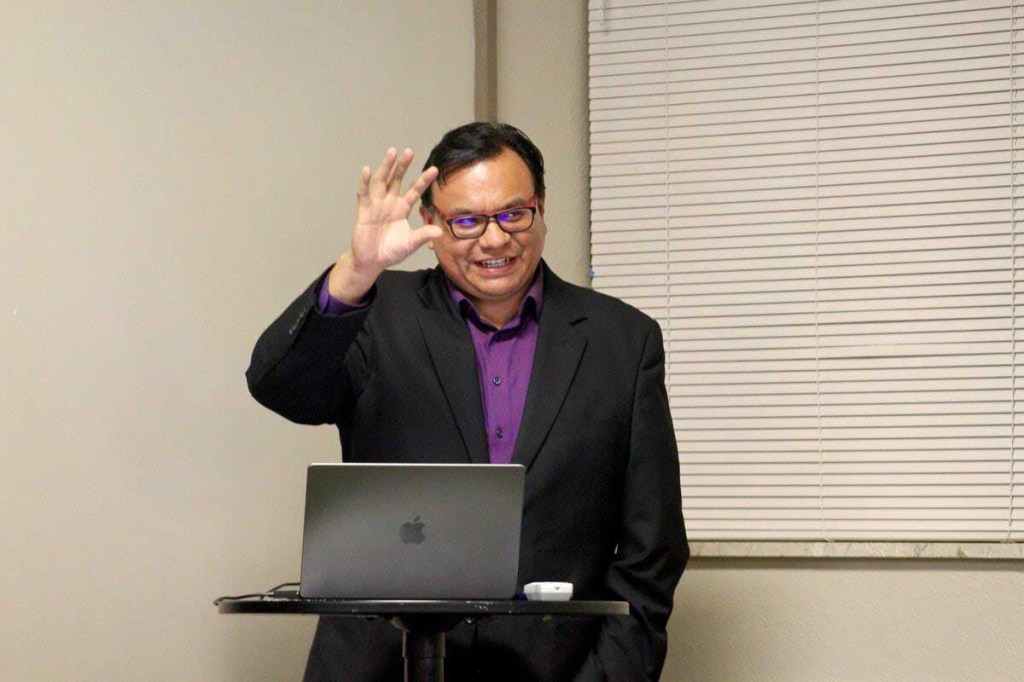Award-winning Cherokee artist details life, explains revitalization of Native language
Published 7:09 am Thursday, November 24, 2022

- Sara Serrano | Daily PressNortheastern State University Sequoyah Fellow Roy Boney Jr. presented at NSU on Nov. 17.
TAHLEQUAH, Oklahoma – An award-winning artist tapped this year by an Oklahoma university for one of its top honors spoke to an audience last week about his perspectives as an artist, and the importance of preserving the Cherokee language.
Northeastern State University Sequoyah Fellow Roy Boney Jr. said he cannot think of a time he was not drawing something. His career as an artist encompasses traditional drawing, painting, digital art, animation, and beyond, as well as his work in Cherokee language revitalization.
Boney grew up around many Cherokee speakers, including his father and grandfather, and feels he took that experience for granted. Losing those people has made it “urgent and personal” for him to do this work.
Boney’s lecture was titled “Atsalagi Ditlilostanvsgi,” which is Cherokee for “A Cherokee Artist.”
“Atsalagi” essentially refers to something that is Cherokee, while the word “ditlilostanvsgi” required Boney to break it down into parts as was once done for him. Boney explained that “di” means “plural”; “atli” means “long, rigid on a flat surface”; “ilos” means “repetition”; “do” means “to use with”; and “di” means “object.”
This one of many the Cherokee words that mean “art,” as described to Boney by Cherokee linguist Durbin Feeling, with whom Boney worked for many years.
“So this Cherokee word for art — it’s like you’re taking small measurements of something and you’re going to repeatedly go around it or kind of trying to recreate what you see,” said Boney. “So for me, as an artist, that’s kind of why it stood out to me.”
Boney showcased this concept of repetition in various pieces of tribal art and explained that it represents how some Cherokee people view the world as made up of many little pieces.
“Even if you look at it scientifically, the world is made up of little bit of atoms, matter — it’s all tiny of bits, it’s measured and there’s a reason for it,” he said. “So the same hold true if you’re thinking of drawing or painting, or even doing brushstrokes or basket making, whatever it is.”
Boney demonstrated this idea by showing a zoomed-in image of beadwork.
“When you look at digital imagery real closely, you see the little blocks of pixels, but when you zoom out to the full piece, you’ll see another beaded piece,” he said. “All these little pieces come together and make something.”
Boney went further, presenting the similarity between Cherokee basket weaving and a piece of circuitry.
“So I see this connection between the Cherokee worldview and technology, and how we view the world, how we use objects to make the world better around us,” he said.
Boney has used technology throughout his career and with art, from programming a short video game about Cherokee syllabary creator Sequoyah to working with Cherokee Language Department on ways making the language compatible with digital media.
“So my journey as an artist, it has been an interesting path. I never expected to do what I’m doing in terms of language or anything. It all just kind of came together, and I learned to enjoy the ride,” said Boney.
Boney hopes he can help artists and others do what they’re trying to do.
“And I hope in some small way to make a difference in that way in the world,” he said.





